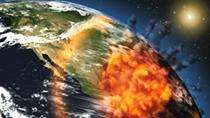Probing Question: Why did mammals survive the 'K/T extinction'?

Picture a dinosaur. Huge, menacing creatures, they ruled the Earth for nearly 200 million years, striking fear with every ground-shaking stride. Yet these great beasts were no match for a 6-mile wide meteor that struck near modern-day Mexico 65 million years ago, incinerating everything in its path.
This catastrophic impact -- called the Cretaceous-Tertiary or K/T extinction event -- spelled doom for the dinosaurs and many other species. Some animals, however, including many small mammals, managed to survive.
How did they do it?
"They were better at escaping the heat," said Russ Graham, senior research associate in geosciences at Penn State. "It was the huge amount of thermal heat released by the meteor strike that was the main cause of the K/T extinction."
He said underground burrows and aquatic environments protected small mammals from the brief but drastic rise in temperature. In contrast, the larger dinosaurs would have been completely exposed, and vast numbers would have been instantly burned to death.
After several days of searing heat, the earth’s surface temperature returned to bearable levels, and the mammals emerged from their burrows, but it was a barren wasteland they encountered, one that presented yet another set of daunting conditions to be overcome, Graham said. It was their diet which enabled these mammals to survive in habitats nearly devoid of plant life.
"Even if large herbivorous dinosaurs had managed to survive the initial meteor strike, they would have had nothing to eat," he said, "because most of the earth’s above-ground plant material had been destroyed."
Mammals, in contrast, could eat insects and aquatic plants, which were relatively abundant after the meteor strike. As the remaining dinosaurs died off, mammals began to flourish. Although representatives from other classes of animals also survived the K/T extinction -- crocodiles, for instance, had the saving ability to take to water -- mammals were clearly the main beneficiaries and they have since spread to nearly every corner of the planet.
Provided by Pennsylvania State University














